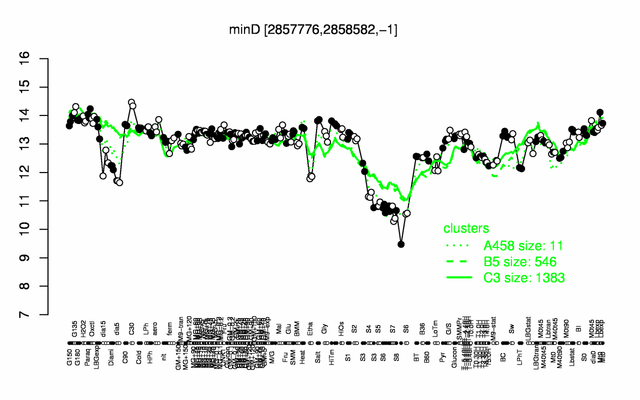Difference between revisions of "MinD"
(→Original Publications) |
|||
| Line 154: | Line 154: | ||
<pubmed> 19884039 24367361</pubmed> | <pubmed> 19884039 24367361</pubmed> | ||
==Original Publications== | ==Original Publications== | ||
| − | <pubmed>8459776,19019154,11886553,9808628,1400224,12368265,10411726,15317782,12492861, 20352045, 11886553 20566861 18179421 21821766 22457634 21926231 24097947 </pubmed> | + | <pubmed>8459776,19019154,11886553,9808628,1400224,12368265,10411726,15317782,12492861, 20352045, 11886553 20566861 18179421 21821766 22457634 21926231 24097947 25374563 </pubmed> |
[[Category:Protein-coding genes]] | [[Category:Protein-coding genes]] | ||
Revision as of 10:04, 7 November 2014
- Description: cell-division inhibitor (septum placement), part of the Min system (with DivIVA, MinC, MinJ), Noc and the Min system ensure the efficient utilization of the division site at midcell in by ensuring Z ring placement
| Gene name | minD |
| Synonyms | divIVB1 |
| Essential | no |
| Product | cell-division inhibitor |
| Function | septum placement |
| Gene expression levels in SubtiExpress: minD | |
| Interactions involving this protein in SubtInteract: MinD | |
| MW, pI | 29 kDa, 4.984 |
| Gene length, protein length | 804 bp, 268 aa |
| Immediate neighbours | spoIVFA, minC |
| Sequences | Protein DNA DNA_with_flanks |
Genetic context 
This image was kindly provided by SubtiList
| |
Expression at a glance PubMed
| |
Contents
Categories containing this gene/protein
cell division, cell envelope stress proteins (controlled by SigM, V, W, X, Y), membrane proteins
This gene is a member of the following regulons
The gene
Basic information
- Locus tag: BSU27990
Phenotypes of a mutant
Database entries
- BsubCyc: BSU27990
- DBTBS entry: [1]
- SubtiList entry: [2]
Additional information
- A mutation was found in this gene after evolution under relaxed selection for sporulation PubMed
The protein
Basic information/ Evolution
- Catalyzed reaction/ biological activity: The Min system prevents minicell formation adjacent to recently completed division sites by promoting the disassembly of the cytokinetic ring, thereby ensuring that cell division occurs only once per cell cycle PubMed
- Protein family: MinD subfamily (according to Swiss-Prot)
- Paralogous protein(s):
Extended information on the protein
- Kinetic information:
- Modification:
- Effectors of protein activity:
Database entries
- BsubCyc: BSU27990
- Structure:
- UniProt: Q01464
- KEGG entry: [3]
- E.C. number:
Additional information
Expression and regulation
- Regulatory mechanism:
- Additional information:
- number of protein molecules per cell (minimal medium with glucose and ammonium): 716 PubMed
- number of protein molecules per cell (complex medium with amino acids, without glucose): 813 PubMed
- number of protein molecules per cell (minimal medium with glucose and ammonium, exponential phase): 3544 PubMed
- number of protein molecules per cell (minimal medium with glucose and ammonium, early stationary phase after glucose exhaustion): 1500 PubMed
- number of protein molecules per cell (minimal medium with glucose and ammonium, late stationary phase after glucose exhaustion): 6195 PubMed
Biological materials
- Mutant:
- Expression vector:
- lacZ fusion:
- GFP fusion:
- two-hybrid system:
- Antibody:
Labs working on this gene/protein
Your additional remarks
References
Reviews
Imrich Barák
Open questions about the function and evolution of bacterial Min systems.
Front Microbiol: 2013, 4;378
[PubMed:24367361]
[WorldCat.org]
[DOI]
(P e)
Marc Bramkamp, Suey van Baarle
Division site selection in rod-shaped bacteria.
Curr Opin Microbiol: 2009, 12(6);683-8
[PubMed:19884039]
[WorldCat.org]
[DOI]
(I p)
Original Publications